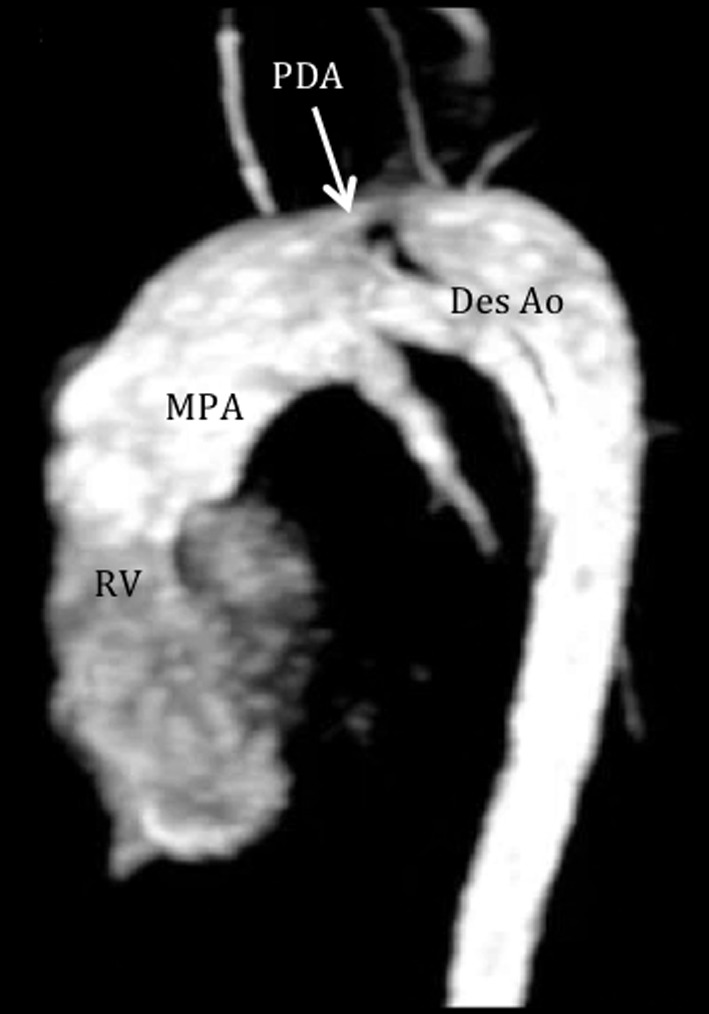Patent ductus arteriosus MRI
|
Patent Ductus Arteriosus Microchapters |
|
Differentiating Patent Ductus Arteriosus from other Diseases |
|---|
|
Diagnosis |
|
Treatment |
|
Medical Therapy |
|
Case Studies |
|
Patent ductus arteriosus MRI On the Web |
|
American Roentgen Ray Society Images of Patent ductus arteriosus MRI |
|
Risk calculators and risk factors for Patent ductus arteriosus MRI |
Editor-In-Chief: C. Michael Gibson, M.S., M.D. [1]; Associate Editor-In-Chief: Priyamvada Singh, M.B.B.S. [2], Cafer Zorkun, M.D., Ph.D. [3],Ramyar Ghandriz MD[4] Assistant Editor-In-Chief: Kristin Feeney, B.S. [5]
Overview
Magnetic resonance imaging can be helpful as a diagnostic tool in conditions where the echocardiographic findings are inconclusive.
MRI
Magnetic resonance imaging (MRI) can be used as a diagnostic modality in congenital heart diseases.[1][2][3][4][5][6]
Advantages
- It can be used in cases where echocardiographic results are inconclusive.
- Helps in measuring heart volumes, blood flow and ventricular wall thickness.
- The magnetic resonance angiography helps in better visualization of heart vasculature.
- Phase velocity mapping helps in measuring the ratio of pulmonary to systemic blood flow (Qp: Qs).
Disadvantages
- For successful MRI procedure breath-holding is required, which is sometimes difficult to achieve with small kids. Due to this, the procedure is done under general anesthesia in children.
- In patients with patent ductus arteriosus, the usage of MRI can demonstrate the abnormality and its severity. The magnitude of the shunt can also be determined by radionuclide flow studies.

References
- ↑ Lee, Hyung Geun; You, Dong Do; Paik, Kwang Yeol; Heo, Jin Seok; Choi, Seong Ho; Choi, Dong Wook (2008). "Prognostic Factors for Primary Duodenal Adenocarcinoma". World Journal of Surgery. 32 (10): 2246–2252. doi:10.1007/s00268-008-9678-6. ISSN 0364-2313.
- ↑ Zeng, Yongyi; Zhang, Da; Wu, Ming; Liu, Ying; Zhang, Xiang; Li, Ling; Li, Zheng; Han, Xiao; Wei, Xueyong; Liu, Xiaolong (2014). "Lipid-AuNPs@PDA Nanohybrid for MRI/CT Imaging and Photothermal Therapy of Hepatocellular Carcinoma". ACS Applied Materials & Interfaces. 6 (16): 14266–14277. doi:10.1021/am503583s. ISSN 1944-8244.
- ↑ Jain, Amish; Shah, Prakesh S. (2015). "Diagnosis, Evaluation, and Management of Patent Ductus Arteriosus in Preterm Neonates". JAMA Pediatrics. 169 (9): 863. doi:10.1001/jamapediatrics.2015.0987. ISSN 2168-6203.
- ↑ Goitein, Orly; Fuhrman, Carl R.; Lacomis, Joan M. (2005). "Incidental Finding on MDCT of Patent Ductus Arteriosus: Use of CT and MRI to Assess Clinical Importance". American Journal of Roentgenology. 184 (6): 1924–1931. doi:10.2214/ajr.184.6.01841924. ISSN 0361-803X.
- ↑ Clarke JR, Strohm O, Patton DJ (2009). "Patent ductus arteriosus demonstrated in an adult patient using cardiovascular magnetic resonance imaging". Can J Cardiol. 25 (1): e17. doi:10.1016/s0828-282x(09)70025-x. PMC 2691885. PMID 19148344.
- ↑ Kozak, Marcelo F; Mertens, Luc; Ho, Ashley; Yoo, Shi-Joon; Grosse-Wortmann, Lars (2012). "Quantification of ductal blood flow with magnetic resonance imaging in newborns with obstructive left heart disease". Journal of Cardiovascular Magnetic Resonance. 14 (S1). doi:10.1186/1532-429X-14-S1-P118. ISSN 1532-429X.
- ↑ "Coarctation of the Aorta and a Parachute Mitral Valve in an Adult With Differential Cyanosis".